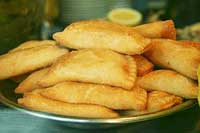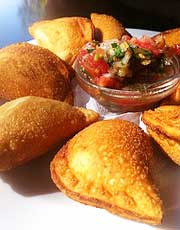
Origin: Galicia
Empanadas are a classic example of Spanish food, which have their origins in the autonomous community of Galicia in the North-West corner of Spain. These bread pies are filled with various fillings including meat, fish, cheese and vegetables, and even fruit to create a dessert version of the dish.

This recipe is for a tuna and goat cheese filling which is still a typical filling from the region as some of the earliest versions of the dish were made with fish, and in particular tuna, which is commonly found in Spain thanks to its extensive coastline. This recipe makes the smaller, bite size versions of the dish which are called 'empanadillas'. These little Spanish pies are therefore great party food and can even be taken on picnics and eaten cold.
Empanadillas are one of the main players in Galician gastronomy. Throughout the region one can find many variations and it is said that every Galician family, bar and restaurant claims to have the best recipe for empanadas. So make sure to go and try all the different types if you ever visit Spain!
The history of these mini Spanish pasties is actually closely linked to the Moorish occupation of Spain back in medieval times. It is believed that the Spanish version of the dish actually derives from the small Arabic pies called samosas. The large version, empanadas were first mentioned in a Catalan cookbook called 'Libre del Coch' which was published in 1520 by Ruperto de Nola who wrote about empanadas with seafood fillings.
The word empanada comes from the Spanish verb 'empanar' which those of you who study Spanish abroad will know means to wrap or coat in bread, referring to the way the Spanish pie is made.
Empanadas have also become very popular in Latin America which is thanks to the large number of Galician immigrants who settled on the continent. The empanada gallega is therefore quite easy to find in many countries across South America, and many countries have their own versions of the dish.
The beauty of empanadas is there variety and there are a number of different fillings that you could try out. Tuna and Goat's cheese is a great filling for these empanadillas as tuna is a typical fish which is eaten Spanish and especially in Galicia. Goat's cheese too is traditionally a very Mediterranean food and compliments the fish well. So if you are holding a Spanish or Mediterranean dinner party, why not make these cute little Spanish pies.

Ingredients:
Preparation: